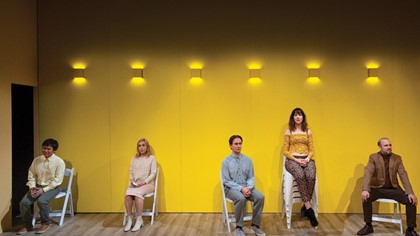My Dearworthy Darling began around three years ago when Emma, Kate and I met to discuss the possibility of me writing a script designed specifically for the kind of theatre THE RABBLE makes. I was heading to France for a writing residency at La Chartreuse National Centre for Theatre Writing, which meant I had some rare open time. I suggested vaguely that maybe I could create something drawing on the writing of medieval mystic women, specifically the 14th-century mystic Margery Kempe, whose book— dictated, as these texts usually were, to her confessor—has long amused and intrigued me. We all agreed that might be an interesting idea.
La Chartreuse is a medieval monastery, so it was definitely the right setting for the project: a beautiful, quiet space designed for contemplation. I read a lot of contemporary plays and poems, and of course, I re-read The Book of Margery Kempe. And I came back with a text that was quite different from whatever it was—I actually can’t remember now—that I first imagined. Margery was still there, but other people and other conversations had crept in as well.
Writing My Dearworthy Darling was very much like writing a poem.
I could say that I think it’s about trauma, about how people are pressured and broken by the dehumanisations of modern capitalism; that it’s a play about three people who don’t know how to communicate and so hurt each other; that it’s about how we can’t ignore our emotional and spiritual needs without paying a terrible price. But I’m not sure that’s for me to decide. It’s very difficult to discuss the meaning of your own work without feeling fraudulent. For me, writing is not so much about conscious intention as it is about process and discovery. Writing a poem is for me about an acute inner listening to the sensual properties of language, which is inseparable from the ideas that surround and infuse it. It’s about bringing conscious intellection and feeling together into a single act.
What I can say is that the collaboration that has brought this text to the stage has been, in all its various stages of development, a rare, profoundly generous experience.
Together, Kate and Emma create a space of remarkable artistic freedom. As with making a poem, this process has been about meticulous listening: but this time to all the other artists in the room. Everyone working on this show has together created a mutual vocabulary; the rhythms I heard in my head have evolved past what I could possibly have imagined on my own, into the bodies, voices, and imaginations of others.
I couldn’t have found better collaborators. Our aim was to make a work of theatre in which the meanings of its many languages—visual design, sound, embodied movement and text— are deeply embedded in each other from the beginning. And this is what we have made: a single, complex, multiply-voiced act, authored by all of us.
Alison Croggon, writer of My Dearworthy Darling
